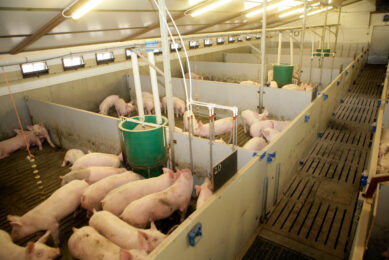3 major pig health issues

Recently, a number of things have happened on the EU medicines front. Some are positive but some are also negative, pig health expert David Burch noted. He’s touching on zinc oxide, a new antibiotic critical priority list and where to go with the EMA?
I must congratulate the European Commission (EC) for coming up with a suitable compromise, allowing those member states to ban zinc oxide or not and those that do use it extensively, can continue for another 5 years.
That the EC is listening, will certainly be appreciated by the pig producers, but in the meantime producers and their vets will need to look for suitable alternatives and husbandry improvements. It also highlights some of the issues around medicines.
Zinc oxide: more research would be welcome
Zinc oxide is a generic compound, without any patent protection as such, and so investing in extensive research to properly evaluate the environmental concerns over the product are unlikely to take place, unless government or industry supported. There is not enough profit in it for a pharmaceutical company to invest in the work as direct competitors will also benefit.

Find out all there is to know about pig health using Pig Progress’ unique Pig Health Tool
This has happened to other compounds, such as dimetridazole (Emtryl), which was used for the treatment of swine dysentery in the old days – nobody would defend it. As a result we lost an important product and are unlikely to get it back.
Overzealous reaction can cause problems
There is still a gaping hole, specifically in the turkey market for products that will treat ‘blackhead’ or histomoniasis also treated by dimetridazole. We have a saying in the UK, “we must not throw the baby out with the bathwater” and sometimes an overzealous reaction or response can cause more of a problem than it solves and puts more pressure on the remaining products, such as antibiotics, causing their over-use and potential resistance development.
It is hoped after Brexit, the environmental issues for zinc oxide may be re-addressed on a national basis in the UK.
WHO research priority list
In a recent publication the World Health Authority (WHO) published their priority pathogens list for research and development of new antibiotics, see also Table 1. Many of the antibiotics or bacteria of concern are not related to animal health or especially to pigs.
In the Critical Priority 1 category, carbapenems are not licensed for use in veterinary medicine so resistance is primarily related to direct human use and environmental contamination by human waste. Third generation cephalosporins (e.g. ceftiofur) are used in veterinary medicine and were very popular in chicks, pigs and increasingly in dairy cattle, because it had a zero withdrawal period in milk. Where we have been able to look at the transmission of resistance genes from animals to man it is less than 1% of clinical cases and appear to come mostly from poultry, where it was widely used and is now banned in the EU.
MRSA – not so much related to pigs
In the High Priority 2 section, vancomycin is not licensed for use in veterinary medicine but a growth promoter avoparcin, a related compound, was used but was banned in the EU approximately 20 years ago; so resistance now is mainly human-use associated.
Methicillin-resistant Staphylococcus aureus (MRSA) have been found in animal production, especially in pigs but approximately 90% of the cases of livestock-associated MRSA in Denmark were related to direct pig contact (farmers & vets) and very little occurred in the general public, especially in towns etc demonstrating that transmission via meat and food contamination is very unlikely. Carrier status of LA-MRSA in the EU was calculated at 0.002% in comparison with the human form of MRSA, which may infect up to 2.0% of the human population – a 1,000 times higher. Methicillin sensitive S. aureus (MSSA) caused 72 times more cases than MRSA.
Salmonella and Campylobacter
Fluoroquinolones are widely used in veterinary medicine and there is justifiable concern in relation to Salmonella and Campylobacter spp resistance transmission. Dutch work showed that only 0.3% of Campylobacter infections came from pigs but 67% came from poultry – hence the use of chlorine to wash the carcasses in the US. Salmonella spp infections are still an issue with S. Typhimurium from pigs a common source.
The Medium Priority 3 section mainly comprises human only infections. Likewise, M. tuberculosis is also human related and comprises a major problem in certain countries, where it is endemic. It can therefore be seen that very little resistance is associated with animal use of antibiotics, as we are led to believe, and it is only a few (zoonotic) infections that are of any major significance e.g. Salmonella and Campylobacter spp.
Cascade use of antibiotics
The European Medicines Agency (EMA) has issued a ‘reflection paper’ on off-label use of antimicrobials in veterinary medicine, just before the main holiday break. Off-label use or ‘cascade’ use of antibiotics is very common, especially in the minor species, as many products have not been approved for use.
The potential market is often seen as being too small for pharmaceutical companies to spend a lot of money developing a claim, especially if it is a generic compound. Usually, the claim or indication is an extension of use to an existing product, which may even be approved in the same species, so the dose, duration of use, species safety and withdrawal period have already been established.
Risks mitigated by extended withdrawal periods
The risk of doing any harm to the animal or risk of unusual residues in the meat and thereby consumer safety are minimal. Even when a different dose or a new species of animal is involved the withdrawal period is extended to protect the consumer. The alternative is disease and often damage to the health and welfare of the animal(s) that need to be treated.
In this paper there is a small section, stating: “Given that peer-reviewed scientific literature or veterinary conferences can be quoted as evidence for some off-label practices, editors could be encouraged to carefully consider the concepts of appropriate and inappropriate off-label antimicrobial uses in their journal scientific policy for the acceptance of manuscripts.”
Tantamount to censorship: we need a debate
To me, as a veterinarian, this is over-prescriptive, tantamount to censorship, and I hope that it will be rejected by the industry. I have often advised colleagues and their clients on the use of compounds, primarily for disease eradication programmes and on newly discovered infections and have published data to increase awareness and help. This can then lead to open debate and discussion.
Having worked with the pharmaceutical industry for many years they are also interested in new indications and will try to develop compounds, if the market is significant enough e.g. blackhead in turkeys, intestinal spirochaetosis in layers. To have these innovations squashed by the authorities, I consider a very negative, unnecessary approach to future veterinary medical developments.
Relocation of the EMA
It has been a privilege to have the EMA based in London over the last 20 years, but with Brexit approaching it will now relocate to another city and another country. Apparently, 19 member states are seeking its new location and I wish them well, they will be very fortunate. It is a critical institution for the development and licensing of new medicines and vaccines, for the future of veterinary and human medicine.











